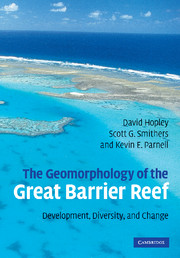Book contents
- Frontmatter
- Contents
- Preface
- Acknowledgements
- 1 Geomorphology and the Great Barrier Reef
- 2 Foundations of the Great Barrier Reef
- 3 Sea level: a primary control of long-term reef growth and geomorphological development
- 4 Oceanography, hydrodynamics, climate, and water quality as influences on reef geomorphological processes
- 5 Spatial analysis of the morphology of the reefs and islands of the Great Barrier Reef
- 6 The non-reefal areas of the continental shelf
- 7 Fringing and nearshore coral reefs
- 8 The mid-shelf reefs of the Great Barrier Reef
- 9 The coral reefs of the outer shelf of the Great Barrier Reef
- 10 Islands of the Great Barrier Reef
- 11 The accumulation of the Holocene veneer to the Great Barrier Reef
- 12 The Holocene evolution of the Great Barrier Reef province
- 13 Geomorphology's contribution to the understanding and resolution of environmental problems of the Great Barrier Reef
- References
- Geographic index
- Subject index
6 - The non-reefal areas of the continental shelf
Published online by Cambridge University Press: 22 August 2009
- Frontmatter
- Contents
- Preface
- Acknowledgements
- 1 Geomorphology and the Great Barrier Reef
- 2 Foundations of the Great Barrier Reef
- 3 Sea level: a primary control of long-term reef growth and geomorphological development
- 4 Oceanography, hydrodynamics, climate, and water quality as influences on reef geomorphological processes
- 5 Spatial analysis of the morphology of the reefs and islands of the Great Barrier Reef
- 6 The non-reefal areas of the continental shelf
- 7 Fringing and nearshore coral reefs
- 8 The mid-shelf reefs of the Great Barrier Reef
- 9 The coral reefs of the outer shelf of the Great Barrier Reef
- 10 Islands of the Great Barrier Reef
- 11 The accumulation of the Holocene veneer to the Great Barrier Reef
- 12 The Holocene evolution of the Great Barrier Reef province
- 13 Geomorphology's contribution to the understanding and resolution of environmental problems of the Great Barrier Reef
- References
- Geographic index
- Subject index
Summary
Introduction
In Chapter 2 the processes involved in the evolution of the continental shelf on which the Great Barrier Reef (GBR) is located were described. They involved alternating phases of offlapping terrigenous sedimentation and emplacement of onlapping marine facies. The period since the last interglacial is the latest of these episodes, the fall in sea level after 120 000 years BP exposing the shelf to varying degrees, with maximum exposure about 19 ka years ago (Chappell et al., 1996; Section 3.3.2) placing the shoreline on the shoulder of the shelf. Subaerial processes dominated most of the shelf for most of the period between the last interglacial and the rapid postglacial drowning after 19 ka years. However, it is during this last episode of drowning and subsequent Holocene stillstand (Chapter 3) that marine and nearshore processes have dominated and have produced the present pattern of superficial sediments. This chapter first describes the surface sediments of the shelf, then examines their three-dimensional properties and the nature of the late Pleistocene surface over which they have been deposited. Special attention is given to the shelf bioherms formed by calcarous algae, the Halimeda banks, the presence and extent of which has only become apparent over the last 25 years.
Much of the information on surface sediments has been available since the publication of Maxwell's classic Atlas in 1968.
- Type
- Chapter
- Information
- The Geomorphology of the Great Barrier ReefDevelopment, Diversity and Change, pp. 166 - 190Publisher: Cambridge University PressPrint publication year: 2007



